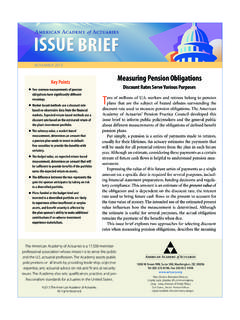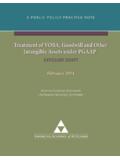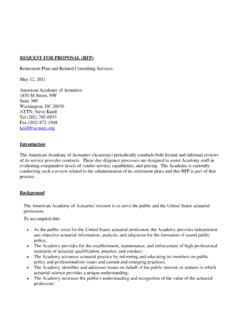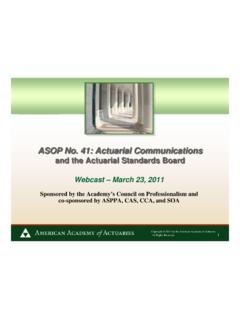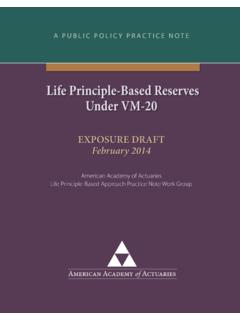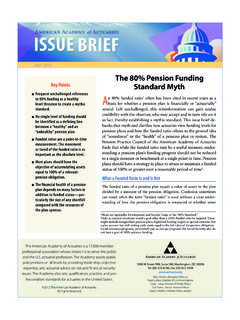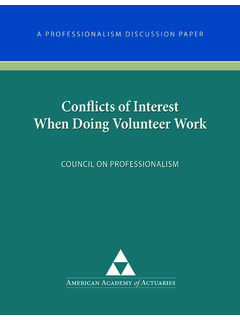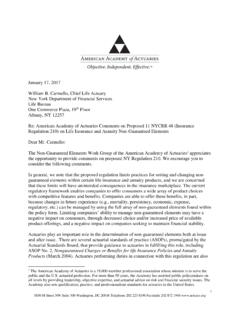Transcription of THE NATIONAL FLOOD INSURANCE PROGRAM: APRIL 2017
1 American Academy of Actuaries FLOOD INSURANCE Work GroupTHE NATIONAL FLOOD INSURANCE PROGRAM: CHALLENGES AND SOLUTIONSAPRIL Musulin, MAAA, ACAS, ChairpersonClifford Angstman, MAAA, FSA, CERAE mmanuel Bardis, MAAA, FCASJ oanne Briody, MAAA, FSAP atrick Causgrove, MAAA, FCASKay Cleary, MAAA, FCAS, FCAKurt Dickmann, MAAA, FCASE dward Ford, MAAA, FCASR. Dale Hall, MAAA, FSA, CERA, CFAJ onathan Hayes, MAAA, ACASJohn Kulik, MAAA, FCASH oward Kunst, MAAA, FCASM inchong Mao, MAAA, FCAS, FSAStu Mathewson, MAAA, FCASM ichael Mendel, MAAA, FCASB ernard Rabinowitz, MAAA, FIA, FCIA, FSA, CERAA chille Sime-Lanang, MAAA, CERA, FSAK athy Thompson, MAAA, ACASAndy Tran, MAAA, ACASA lexander Turrell, MAAA, FCASN ancy Watkins, MAAA, FCAST revar Withers, MAAA, ACASY anjun Yao, MAAA, FCASR ichard Yocius, MAAA, FCASJ effrey McCarty, MAAA, FCAS, CERA (Ex-Officio)
2 Marc Rosenberg Senior Casualty Policy AnalystJim MacGinnitie, MAAA, FCAS, FSA Senior Casualty FellowFlood INSURANCE Work GroupThe American Academy of Actuaries is a 19,000-member professional association whose mission is to serve the public and the actuarial profession. For more than 50 years, the Academy has assisted public policymakers on all levels by providing leadership, objective expertise, and actuarial advice on risk and financial security issues. The Academy also sets qualification, practice, and professionalism standards for actuaries in the United States. AMERICAN ACADEMY OF ACTUARIES1850 M STREET NW, SUITE 300, WASHINGTON, 20036202-223-8196 | 2017 American Academy of Actuaries.
3 All rights 1: Executive Summary ..1 Section 2: Purpose and Scope ..5 Section 3: Background Key Aspects of the Evolution of the Program ..7 Section 4: Structure of the NATIONAL FLOOD INSURANCE Program ..17 Section 5: Interaction With Other Federal programs , Building Codes, and Land Use Planning ..25 Section 6: Funding and Capital ..28 Section 7: Technical Tools Maps and Modeling ..37 Section 8: Future Issue Rising Sea Levels ..46 Section 9: Actuarial Standards, Principles, Soundness, and the NFIP ..52 Section 10: Private Sector INSURANCE and the NFIP ..60 Section 11: An Example of How Property Risk Pools Have Been Addressed at the State Level.
4 69 Section 12: Potential Congressional Reforms ..72 Section 13: Summary and Conclusions ..77 THE NATIONAL FLOOD INSURANCE PROGRAM: Challenges and Solutions 1 Section 1: Executive SummaryThe NATIONAL FLOOD INSURANCE Program (NFIP) is the primary provider of FLOOD INSURANCE in the United States, in partnership with private insurers and servicing contractors. The program was formed to address a lack of coverage being offered in the private INSURANCE market, reflecting limited tools to assess risk and the problem of adverse selection from consumers who usually knew far more about local properties exposure to flooding than did prospective its inception in 1968, the NFIP has been charged with sometimes conflicting mandates: To establish a comprehensive floodplain and coastal FLOOD management framework; To make available affordable FLOOD INSURANCE coverage.
5 To reduce the public s reliance on post-event disaster assistance To encourage widespread participation; and To limit the Treasury s exposure to the need for lending to cover deficits. Although premiums were set at a level that was generally sufficient to cover losses in the program s early decades, they proved unable to fund catastrophic losses from storms like Hurricane Katrina and Superstorm Sandy. Large deficits required significant borrowing from the Treasury, fueling calls for reform of the recent years, improved data availability and computing power have significantly improved the understanding of FLOOD risk and the ability of private insurers to underwrite it.
6 Powerful models have been developed to provide a highly refined view of the peril, and have helped to overcome the reluctance of many insurers to offer FLOOD coverage. In the United States, private insurers are beginning to offer FLOOD coverage, something common in other parts of the world. Global reinsurers are using models to price and make available reinsurance capacity. These developments offer an opportunity to reconsider the NFIP s THE NATIONAL FLOOD INSURANCE PROGRAM.
7 Challenges and SolutionsThe NFIP affects many constituencies, including property owners, local governments, builders, realtors, mortgage lenders, insurers, and taxpayers. The program differs from traditional private INSURANCE in several fundamental ways. Changing it without causing market disruption or triggering unintended consequences may be difficult. The program s current authorization expires in September 2017 and Congress will need to consider many complex and highly technical issues as it debates reauthorization. The American Academy of Actuaries FLOOD INSURANCE Work Group1 developed this monograph to assist Congress and other stakeholders in understanding the key issues surrounding the NFIP and its role in FLOOD management and recovery after catastrophic events.
8 The monograph is comprised of 13 sections followed by two appendices. Following this executive summary, Section 2 covers the monograph s purpose and scope. Section 3 reviews the evolution of the program, identifying key principles underlying its mission. Section 4 describes the program s mission, while Section 5 identifies ways in which the program interacts with others in the federal government. Section 6 discusses the importance of funding and capital to the program, particularly in the context of how it pays claims following catastrophic events. Section 7 reviews the importance of FLOOD modeling and how recent advances in technology and data can enable private markets to offer coverage.
9 Section 8 discusses the benefits of taking a long-term view of the program s finances, using the prospect of rising sea levels to illustrate its exposure to changing conditions over time. Section 9 covers actuarial standards and principles and how they can be used in NFIP ratemaking. Section 10 discusses issues surrounding privatization and Section 11 provides an example of how state experience in tackling property INSURANCE problems can aid in identifying policy ideas for the NFIP. Section 12 summarizes a survey the work group undertook of ideas for reform from various stakeholders. Section 13 presents The FLOOD INSURANCE Work Group was formed by the Academy s Casualty Practice Council to provide actuarial support, advice, and communications on topics that involve FLOOD INSURANCE .
10 Specifically, it is focused on the NATIONAL FLOOD INSURANCE Program and proposed changes to its enabling legislation. It will also be considering the private FLOOD INSURANCE market and relevant reinsurance and catastrophe bond issues. THE NATIONAL FLOOD INSURANCE PROGRAM: Challenges and Solutions 3 Several issues are highlighted in this monograph: The NFIP s mission has evolved over time. Changes in the law have led to some conflicting mandates, particularly between reducing Treasury s exposure to the need for lending to cover program deficits while encouraging widespread participation by keeping premiums affordable and offering subsidies to certain classes of policyholders.
